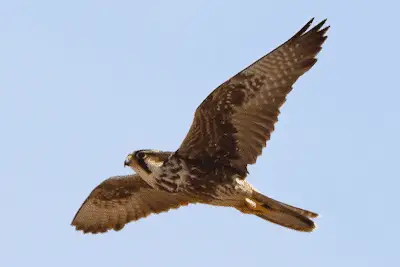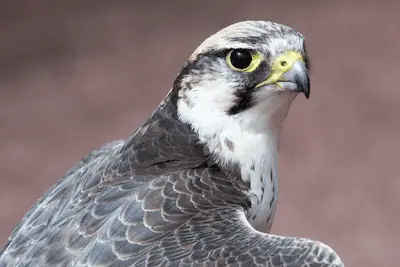Lanner Falcon
(Falco biarmicus)
The Lanner Falcon is one of the rarest raptors in Europe, making it difficult to observe this elegant falcon in the wild if you’re based in Europe.

The best place to observe Lanner Falcons is in Turkey, which is home to the largest population of Lanner Falcon pairs.
Outside of Turkey, the largest concentration of Lanners occurs in Italy, but with a total number of less than 200 breeding pairs, it is exceedingly rare here.
The remaining population of European Lanner Falcons should be closely monitored and protected in order to ensure this beautiful falcon continues to breed in Europe.
Lanner Falcon facts
As a falcon specialized on hunting small birds and mammals, the Lanner Falcon is most often seen gliding at mid height over mountain slopes, ready to swoop down on prey below. In some cases it also soars to a great height, and stoops down from there.
Lanner Falcon size
The Lanner Falcon is a medium sized falcon that resembles a small Peregrine Falcon in its proportions.
- Wingspan: 100-110 cm
- Length: 45-50 cm
- Weight: 700-900 g (female), 500-600 g (male)
Female Lanner Falcons overlap in size with male Peregrine Falcons in Europe, and need to be distinguished based on their coloration pattern.
Appearance
The Lanner Falcon is a medium sized falcon that is most often seen flying at medium altitude while it scans the ground below for suitable prey. While it resembles the Peregrine Falcon, it can be distinguished based on its smaller size, less powerful build, and reddish brown head colour in adults (see photo below).

Sexual dimorphism
Similar to almost all European raptor species, female Lanner Falcons are significantly larger than males, to the extent that they don’t overlap in size.
Lifespan
A maximum age of 17 years has been recorded in captivity.
Scientific name and taxonomy
The scientific name of the Lanner Falcon is Falco biarmicus. There are 5 known subspecies, of which only one occurs in Europe,while the rest are spread throughout Africa. However, the Lanner Falcon is thought to form a superspecies with the closely related Gyrfalcon (Falco rusticolus) and Saker Falcon (Falco cherrug).
Raptor superspecies are thought to have recently diverged from each other during evolution, and are geographically separated into different ranges. In some cases they are still able to form hybrids, but very rarely do so in the wild, due to their non-overlapping distribution.
Lanner Falcon distribution
The Lanner Falcon is found in Europe in Italy and southeastern Europe, but breeds only with a few pairs in each country where it occurs. Outside of Europe, the Lanner Falcon is widespread throughout Africa, the Arabian Peninsula, and the Middle East.
Lanner Falcon habitat
The Lanner Falcon is very flexible in its choice of habitat, and just seems to require two basic conditions when choosing a habitat: the availability of plentiful prey species, as well as cliffs to nest on. Due to the reliance on cliffs for nesting, the Lana Falcon doesn’t occur in lowlands or areas without mountains and canyons. Also occurs at the coast when there are cliffs for it to nest on.
Lanner Falcon population size
The European population of the Lanner Falcon is estimated to be between 500 to 900 breeding pairs, which makes it one of the rarest raptors in Europe. The majority of the pairs attributed to the European population are found in Turkey, with up to 600 pairs.
Lanner Falcon behavior
The Lanner prefers to hunt by flying low over hill slopes and along cliffs, in order to surprise prey on the ground. In some cases also hunts from a perch, or by soaring. Lanner Falcon pairs often work together to catch prey.
Feeding and diet
The largest part of the Lanner Falcon diet is made up of small to medium sized birds, with the predominant species dependent on the location. However, in addition to birds, it also takes small repites, mammals and insects in southern parts of its range. This behavior distinguishes it from Peregrines, which only feed on birds.
Breeding
The Laner Falcon usually nests in cliffs, but also takes advantage of old nests built by other raptors, crows, or stocks. Similar to all falcon species, the Lanner doesn’t build its own nest, and thus depends on the availability of suitable nesting sites. The female lays 2-4 eggs, which are incubated for up to 34 days. After hatching, the young falcons stay in the nest for up to 45 days, and continue to be fed even after they fledge.
Migration
The Lanner Falcon is a partial migrant, with most adult birds sedentary in their breeding locations. However, juvenile falcons are migratory or nomadic, and can move long distances. They often show up in locations with plentiful food supply.
Lanner Falcon conservation status
While the Lanner Falcon is currently one of the rarest raptor species in Europe (with just a few hundred estimated breeding pairs), it is classified as of “Least Concern” by BirdLife International. This is because Europe forms only a small part of the Lanner Falcon’s total range, and it is relatively common in other parts of the world.
Threats
Due to extremely small populations in Europe, the biggest threat to Lanner Falcons is illegal shooting and collection of eggs or young falcons by falconers. Lack of suitable nesting locations is also a problem that limits the range of Lanner Falcons.
Additional resources:
- Barbary Falcon range and distribution
- Eleonora’s Falcon (key facts)
- Red-footed Falcon conservation status
